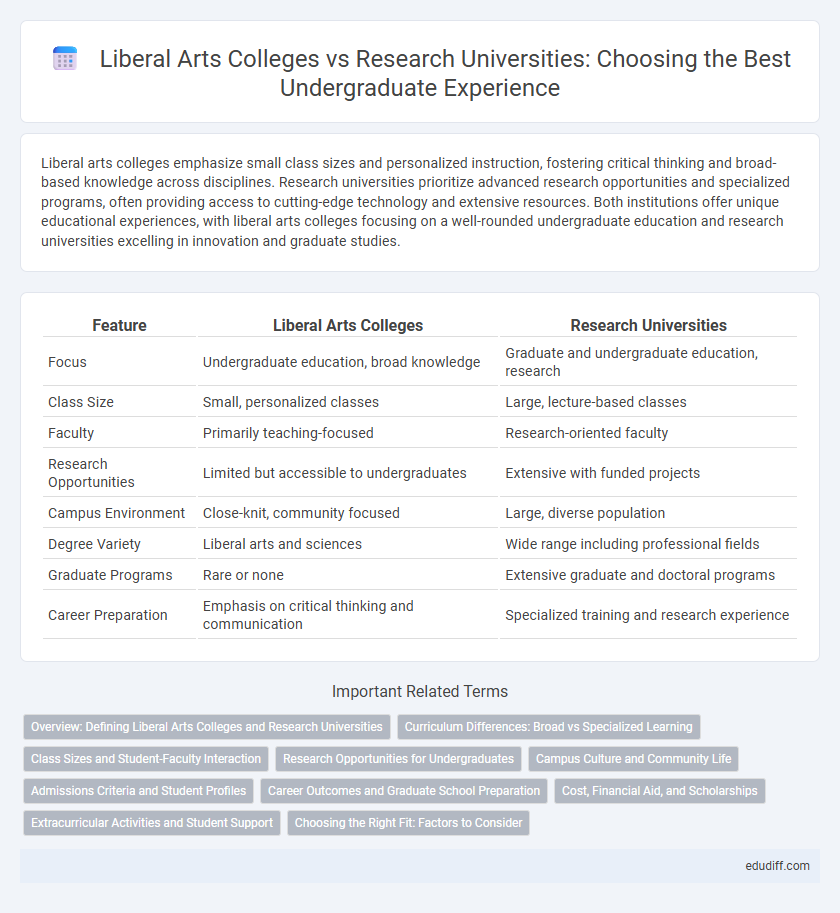Liberal arts colleges emphasize small class sizes and personalized instruction, fostering critical thinking and broad-based knowledge across disciplines. Research universities prioritize advanced research opportunities and specialized programs, often providing access to cutting-edge technology and extensive resources. Both institutions offer unique educational experiences, with liberal arts colleges focusing on a well-rounded undergraduate education and research universities excelling in innovation and graduate studies.
Table of Comparison
| Feature | Liberal Arts Colleges | Research Universities |
|---|---|---|
| Focus | Undergraduate education, broad knowledge | Graduate and undergraduate education, research |
| Class Size | Small, personalized classes | Large, lecture-based classes |
| Faculty | Primarily teaching-focused | Research-oriented faculty |
| Research Opportunities | Limited but accessible to undergraduates | Extensive with funded projects |
| Campus Environment | Close-knit, community focused | Large, diverse population |
| Degree Variety | Liberal arts and sciences | Wide range including professional fields |
| Graduate Programs | Rare or none | Extensive graduate and doctoral programs |
| Career Preparation | Emphasis on critical thinking and communication | Specialized training and research experience |
Overview: Defining Liberal Arts Colleges and Research Universities
Liberal arts colleges primarily emphasize broad-based undergraduate education, fostering critical thinking and interdisciplinary learning across humanities, social sciences, and natural sciences. Research universities combine comprehensive undergraduate programs with extensive graduate studies and significant investment in research facilities, producing specialized knowledge and innovations. The distinction lies in educational approach, institutional size, and focus on research output versus teaching quality.
Curriculum Differences: Broad vs Specialized Learning
Liberal arts colleges emphasize broad learning with a diverse curriculum that fosters critical thinking, writing, and communication across multiple disciplines. Research universities offer specialized learning by providing focused courses and intensive study in specific fields, often tied to advanced research opportunities. Students at liberal arts colleges often experience smaller class sizes and interdisciplinary approaches, while research universities prioritize depth and expertise in the major.
Class Sizes and Student-Faculty Interaction
Liberal arts colleges typically offer smaller class sizes, averaging 15-20 students, which fosters personalized student-faculty interaction and enhances collaborative learning environments. Research universities often have larger classes, especially in introductory courses, with student-to-faculty ratios around 15:1 to 20:1, potentially limiting direct engagement. The intimate setting of liberal arts colleges encourages mentorship and active participation, while research universities provide access to a broader range of faculty expertise and research opportunities.
Research Opportunities for Undergraduates
Liberal arts colleges provide undergraduates with closer faculty interactions and more personalized research mentorship, often resulting in hands-on, interdisciplinary projects. Research universities offer extensive resources, larger research labs, and diverse funding opportunities, enabling students to engage in cutting-edge, large-scale research initiatives. Undergraduates at research universities often collaborate with graduate students and faculty on high-impact publications, fostering a professional research environment.
Campus Culture and Community Life
Liberal arts colleges emphasize close-knit campus communities with small class sizes fostering personalized interactions and a strong sense of belonging among students and faculty. Research universities offer diverse campus cultures driven by larger student populations, numerous extracurricular activities, and vibrant social networks catering to varied academic and personal interests. Students at liberal arts colleges often experience intimate mentorship, while research universities provide extensive resources and opportunities for interdisciplinary collaboration.
Admissions Criteria and Student Profiles
Liberal arts colleges emphasize holistic admissions criteria, valuing diverse extracurricular involvement, personal essays, and letters of recommendation alongside GPA and standardized test scores. Research universities prioritize academic metrics such as GPA, SAT/ACT scores, and advanced coursework, often favoring students with strong STEM backgrounds and research experience. Student profiles at liberal arts colleges tend to include well-rounded individuals with varied interests in humanities and social sciences, while research universities attract applicants focused on specialized scientific or technical fields seeking opportunities for intensive research.
Career Outcomes and Graduate School Preparation
Liberal arts colleges emphasize personalized education and foster critical thinking, leading to strong communication skills and adaptability valued by employers and graduate schools. Research universities offer extensive resources and specialized programs that provide in-depth knowledge and research experience, enhancing preparation for advanced degrees and STEM careers. Career outcomes from liberal arts colleges often include flexibility across multiple fields, while research universities tend to produce graduates with specific technical expertise suited for research-intensive roles.
Cost, Financial Aid, and Scholarships
Liberal arts colleges often have higher sticker prices than research universities but tend to offer generous need-based financial aid and merit scholarships that can reduce overall costs significantly. Research universities may provide a broader range of scholarships, including department-specific awards and research grants, which can offset tuition expenses for STEM and professional students. Evaluating net price calculators and financial aid packages is essential to understanding the true cost difference between these institutions.
Extracurricular Activities and Student Support
Liberal arts colleges offer a close-knit community with personalized student support and a wide range of extracurricular activities, fostering leadership and collaboration. Research universities provide extensive resources and diverse clubs, but extracurricular involvement can be overshadowed by academic demands. Students seeking tailored guidance and meaningful participation often benefit more from the supportive environment at liberal arts colleges.
Choosing the Right Fit: Factors to Consider
Liberal arts colleges provide smaller class sizes and a focus on undergraduate teaching, fostering close faculty-student relationships and interdisciplinary learning. Research universities offer extensive resources, specialized programs, and opportunities for undergraduate research but often have larger classes and a more competitive environment. Prospective students should evaluate factors such as campus culture, academic interests, available resources, class size, and career goals to determine the best fit for their educational experience.
Liberal arts colleges vs Research universities Infographic

 edudiff.com
edudiff.com